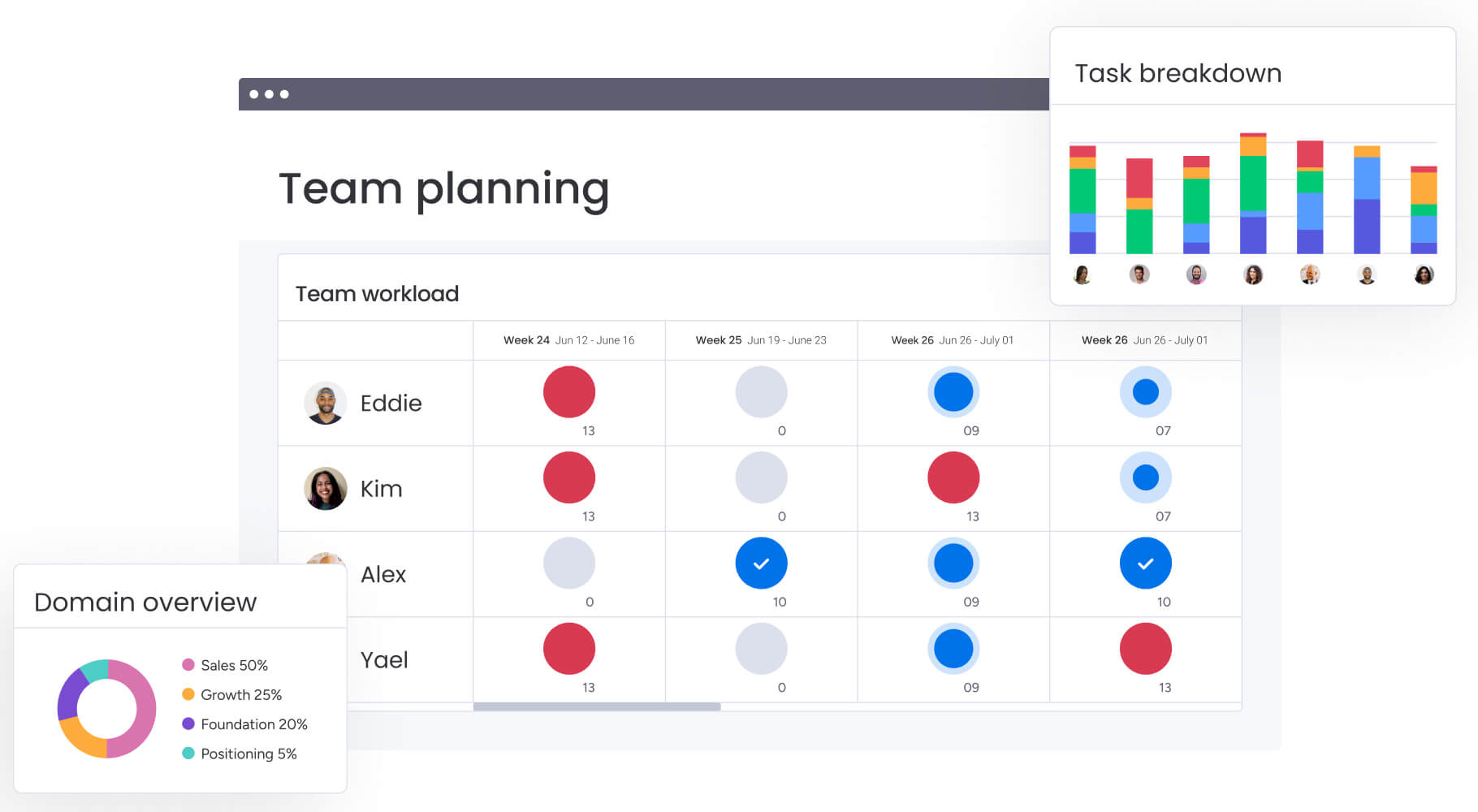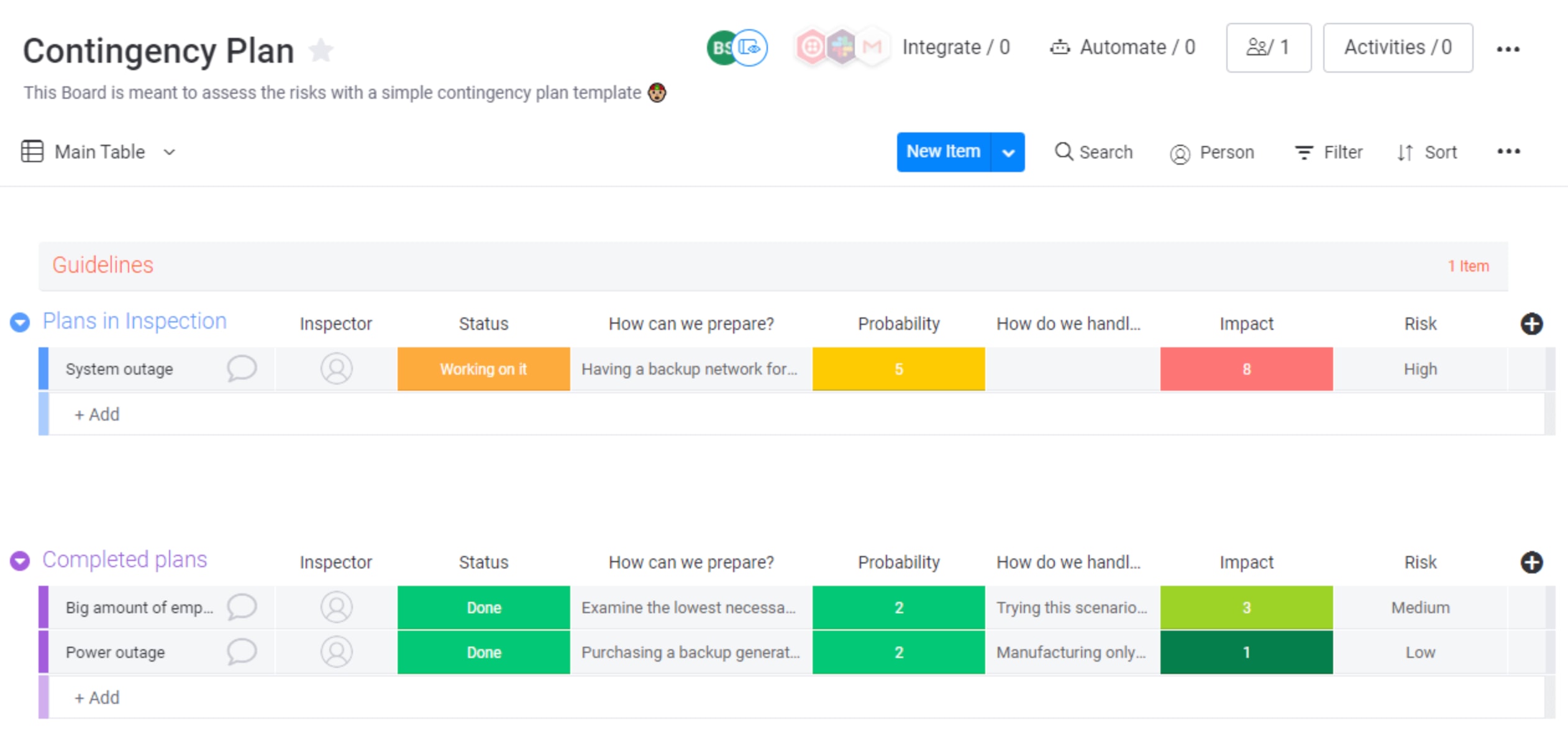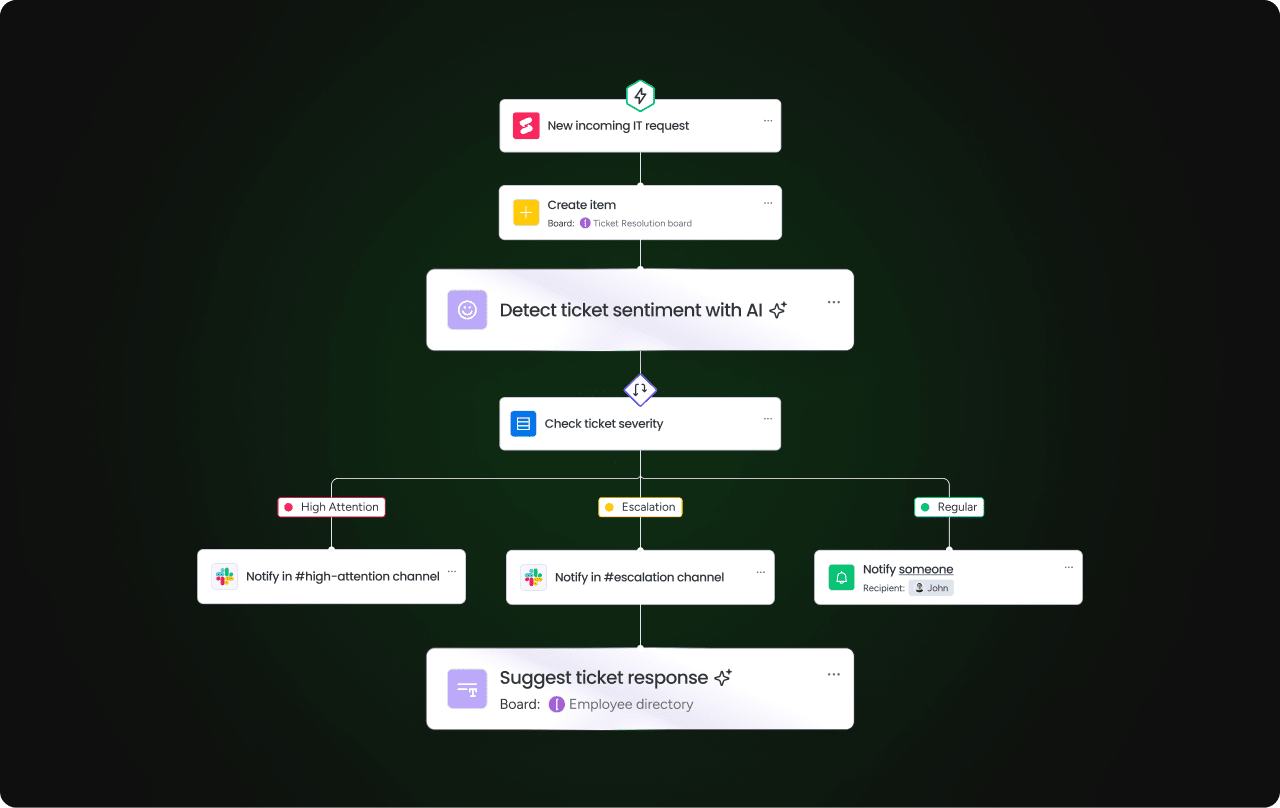Even the most solid business strategies can be fragile. They often rely on a single, predictable view of the future that rarely unfolds as expected, leaving teams scrambling when reality takes a different turn. Effective scenario planning helps organizations move beyond this rigid approach by building resilience and adaptability into their core operations.
It allows teams to explore multiple potential futures and develop robust strategies that hold up no matter what comes next. With a flexible platform like monday work management, teams can collaborate on these plans and track real world indicators seamlessly.
This guide covers the fundamentals of scenario planning, from defining key terms to a five step process for building your own scenarios. We will explore why this method matters for cross functional teams, how to build a robust plan, and what tools can help you transform uncertainty into a competitive advantage.
What is scenario planning?
Scenario planning is a strategic planning method that organizations use to create flexible long-term plans by exploring multiple possible futures. Unlike traditional forecasting that predicts a single outcome, what is scenario planning helps businesses prepare for uncertainty by considering various potential developments and their implications for decision-making.
To define scenario, think of it as a detailed description of one possible future situation, complete with specific conditions and circumstances. What is a scenario in business context? It’s a narrative that explores how current uncertainties might unfold and affect your organization.
Define scenario and scenario-based planning
Understanding the terminology clarifies how this strategic approach works in practice. A scenario represents one plausible future state, while scenario-based planning refers to the systematic process of developing and analyzing multiple scenarios to inform strategic decisions.
Strategic scenario planning integrates this analysis directly into long-term business strategy. Organizations use scenario planning in strategic management to test assumptions and build resilience against unexpected changes.
Scenario planning in strategic management
Scenario planning fits into broader strategic frameworks by helping executives make informed decisions under uncertainty. Rather than relying on single-point forecasts, this method explores multiple possibilities and their potential impacts on business operations.
The process encourages strategic thinking that goes beyond immediate challenges to consider long-term organizational sustainability. What does a scenario mean for your business strategy? It provides a structured way to explore how different futures might require different strategic responses.

Why scenario-based planning matters for businesses
Scenario-based planning has become essential for organizations operating in complex, rapidly changing environments, a shift reflected in how finance leaders increasingly step into broader strategic roles — 8.4% of CEO vacancies at Fortune 500 and S&P 500 firms were filled by CFOs in 2023, the highest figure on record. The method enables businesses to anticipate challenges, identify opportunities, and make strategic decisions with greater confidence.
The approach proves particularly valuable for cross-functional teams that need to coordinate responses to potential changes. When different departments understand possible future scenarios, they can align their planning and resource allocation more effectively.
Key organizational benefits demonstrate why scenario planning a tool for strategic thinking has gained widespread adoption. These advantages span multiple business functions and strategic levels:
- Enhanced risk mitigation: Identify potential threats before they impact operations.
- Improved strategic agility: Adapt quickly when market conditions change
- Informed resource allocation: Make investment decisions based on multiple future possibilities
- Cross-departmental alignment: Unite teams around shared understanding of potential futures
Benefits of scenario planning for cross-functional teams
Scenario planning breaks down departmental barriers by creating shared understanding of potential futures. Teams across marketing, operations, finance, and other functions can coordinate their responses when they understand how different scenarios might affect their work.
The process also improves communication between teams by establishing common language around uncertainty and risk. When everyone understands the same set of potential scenarios, discussions about strategy and resource allocation become more productive and focused.
How scenario forecasting drives adaptability
Scenario forecasting builds organizational flexibility by preparing teams for multiple possible outcomes, echoing expert advice that organizations must be flexible, to be nimble in environments where “change is constant.” Instead of creating rigid plans based on single predictions, organizations develop adaptive strategies that work across different scenarios.
This approach reduces the shock of unexpected events and enables faster response times when conditions change. How prepared is your organization for unexpected market shifts or industry disruptions?
Try monday work management5 steps to build a robust scenario plan
Creating effective scenarios requires a structured approach that engages the right stakeholders and considers relevant uncertainties. The scenario planning process provides a practical framework for developing scenarios that inform strategic decision-making and improve organizational preparedness.
Step 1: Identify key drivers and uncertainties
Start by mapping the factors that could significantly impact your business over the planning horizon. Focus on external forces beyond your direct control, such as economic conditions, regulatory changes, technological developments, and competitive dynamics.
Categorize these drivers based on their potential impact and level of uncertainty. High-impact, high-uncertainty factors become the foundation for scenario development.
Essential driver categories help structure your analysis and ensure comprehensive coverage of relevant factors:
- Economic factors: Interest rates, inflation, and market growth patterns
- Technological changes: Automation trends, digital transformation, new platforms
- Regulatory shifts: Policy changes, compliance requirements, industry standards
- Competitive landscape: New market entrants, industry consolidation, pricing pressures
Step 2: Develop multiple scenario planning models
Create 2-4 distinct scenarios that explore different combinations of your key uncertainties. Avoid developing only best-case and worst-case scenarios, which often lack nuance and practical value.
Use a structured approach like the 2×2 matrix method, which maps scenarios based on two critical uncertainties. This scenario planning framework helps ensure your scenarios cover meaningfully different futures rather than minor variations on the same theme.
Name each scenario descriptively rather than emotionally. Labels like “Rapid Digital Transformation with Economic Stability” provide clearer guidance than “Optimistic Scenario.”
Step 3: Create a scenario planning template
Standardize your scenario documentation to ensure consistency and completeness across all scenarios. A well-designed scenario planning template captures essential information while making scenarios easy to compare and analyze.
monday work management’s customizable templates can help teams maintain consistent structure and facilitate collaboration during scenario development. The platform’s no-code building blocks enable teams to create workflows that support ongoing scenario planning processes.
Essential template components ensure comprehensive scenario documentation and analysis:
- Scenario description: Clear narrative of the future state and key developments
- Key assumptions: Underlying factors that drive this particular scenario
- Timeline considerations: When changes might occur and their sequence
- Impact assessment: Effects on different business areas and functions
- Probability estimates: Likelihood assessments that evolve with new information
Step 4: Analyze implications and choose strategies
Evaluate how each scenario would affect different aspects of your business, from operations and finance to marketing and human resources. Look for strategies that remain robust across multiple scenarios, as these often represent the safest strategic investments.
Develop contingency plans for high-impact scenarios, even if they seem less likely. These plans don’t need to be fully detailed, but they should outline key decision points and response options.
Consider how monday work management’s automation and dashboard capabilities can help monitor key indicators across scenarios. The platform’s real-time tracking features enable teams to spot emerging trends and adjust their strategies accordingly.

Step 5: Track progress with scenario planning tools
Establish monitoring systems to track real-world developments against your scenarios. Identify leading indicators that might signal which scenario is emerging, and create regular review processes to update your scenarios as conditions change.
Modern scenario planning tools offer powerful capabilities for monitoring and analysis. monday work management’s AI features can help automate the tracking of key indicators, analyze trends, and alert teams when significant changes occur.
Regular scenario updates ensure your planning remains relevant and actionable. Schedule quarterly reviews to assess scenario validity and adjust your strategic responses based on new information.
Try monday work managementReal scenario planning examples and techniques
Scenario planning applications vary across industries, but the fundamental principles remain consistent. Organizations use this approach to navigate everything from technological disruption to regulatory changes, supply chain challenges, and market evolution.
Scenario thinking examples and business scenario planning
Here are some real-world examples of how scenario planning is put into action across different industries:
- Technology: Companies explore scenarios related to AI adoption, shifting data privacy regulations, and evolving competition in new markets to inform decisions on product development and market expansion.
- Healthcare: Organizations plan for demographic shifts, new treatment breakthroughs, and policy reforms by envisioning futures with aging populations, innovative medical technologies, and changing healthcare funding models.
- Manufacturing: Businesses focus on scenarios involving supply chain disruptions, resource scarcity, and automation trends — such as regionalizing supply chains or adopting advanced manufacturing technologies—to guide investment and operational planning.
Types of scenario planning and scenario building
Different scenario planning techniques serve different strategic purposes and planning horizons. Understanding these approaches helps organizations choose the most appropriate method for their specific needs and objectives.
Exploratory scenarios start with current trends and project them forward, making them useful for anticipating gradual changes and their cumulative effects.
Normative scenarios begin with desired future states and work backward to identify required actions and conditions.
Challenge scenarios test existing strategies against extreme or disruptive conditions. These scenarios help organizations stress-test their plans and identify vulnerabilities that might not be apparent under normal conditions.
Scenario planning tools and frameworks
Modern scenario planning benefits from digital platforms that facilitate collaboration, data integration, and ongoing monitoring — a trend reflected in findings that 82% of employees now rely on work/project management software to track tasks and collaborate. The right combination of scenario planning framework and technology can make this strategic approach more accessible and actionable for organizations of all sizes.
Using automation to enhance scenario planning process
Automation streamlines many aspects of how to do scenario planning, from data collection and analysis to monitoring and reporting—unsurprising given that 86% of IT professionals already leverage AI for automation, security, and data management. Automated systems can track multiple indicators simultaneously, identify patterns that might escape human attention, and alert teams when significant changes occur.
monday work management’s automation features can trigger alerts when key scenario indicators change, ensuring teams stay informed about emerging trends. The platform’s AI capabilities can analyze large datasets to identify patterns and correlations that inform scenario development and monitoring.
Automated reporting keeps stakeholders informed about scenario developments without requiring manual data compilation. This capability ensures that scenario insights remain visible and actionable throughout the organization.

Evaluating a scenario planning tool for your team
Selecting the right platform requires careful consideration of your organization’s specific needs and capabilities. Key evaluation criteria help ensure you choose a scenario planning tool that supports effective collaboration and analysis.
Collaboration features determine how effectively teams can work together during scenario development and analysis. Data integration capabilities affect how easily you can incorporate relevant information into your scenario analysis.
Essential platform capabilities support comprehensive scenario planning implementation and ongoing management:
- Real-time collaboration: Enable cross-functional teams to work together seamlessly.
- Data integration: Connect with existing systems and data sources automatically.
- Visualization capabilities: Present complex scenarios through charts and interactive displays
- Monitoring and alerts: Track scenario indicators and notify teams of significant changes
- Scalability features: Grow with organizational needs and expanding scenario complexity
Transform uncertainty into opportunity
Scenario planning transforms uncertainty from a source of anxiety into a competitive advantage. Organizations that embrace this approach develop stronger strategic thinking capabilities and become more resilient in the face of change.
The process also improves decision-making quality by forcing teams to consider multiple perspectives and potential outcomes. This broader thinking leads to more robust strategies that perform well across different conditions.
Get started with flexible processes
Begin your scenario planning journey by identifying the key uncertainties facing your organization over the next 2-3 years. Engage cross-functional teams early in the process to ensure comprehensive coverage of relevant factors and build organizational buy-in for the results.
Start with a simple template and 2-3 scenarios before expanding to more complex analyses. The goal is to build scenario planning capabilities gradually while delivering immediate value to strategic planning processes.
Seamless collaboration and AI on monday work management
monday work management provides the collaboration features, AI-driven insights, and workflow automation needed to make scenario planning practical and actionable. The platform’s Digital Workers can monitor scenario indicators continuously, while its automation capabilities ensure teams stay informed about important developments.
The platform’s customizable dashboards provide real-time visibility into scenario-relevant metrics, enabling faster response to changing conditions. Teams can build workflows that automatically trigger responses when specific scenario indicators reach predetermined thresholds, transforming strategic planning from reactive to proactive organizational capability.
Frequently asked questions about scenario planning
What is meant by scenario planning in business strategy?
Scenario planning in business strategy is meant to be a strategic planning method that helps organizations prepare for multiple possible futures by exploring different ways current uncertainties might unfold. This approach enables more flexible and resilient strategic decision-making than traditional forecasting methods.
How often should organizations update their scenario planning models?
Organizations should update their scenario planning models at least annually, though more frequent updates may be necessary during periods of rapid change or when significant new information becomes available that affects key assumptions.
What makes scenario planning different from traditional business forecasting?
Scenario planning differs from traditional business forecasting by exploring multiple possible futures rather than predicting a single outcome, helping organizations prepare for uncertainty rather than betting on specific predictions or linear projections.
How many scenarios should a business develop for effective strategic planning?
Businesses should typically develop 2-4 well-defined scenarios that cover meaningfully different futures, as too few scenarios limit strategic options while too many scenarios become difficult to manage and analyze effectively.
Can small teams implement scenario planning without extensive consulting resources?
Small teams can successfully implement scenario planning using simple templates and digital collaboration platforms, focusing on the most critical uncertainties affecting their business without requiring extensive external consulting resources.
What industries benefit most from scenario-based planning approaches?
Industries facing high uncertainty or rapid change — including technology, healthcare, finance, energy, and manufacturing — benefit most from scenario-based planning approaches, though any organization can apply these methods to improve strategic decision-making capabilities.

